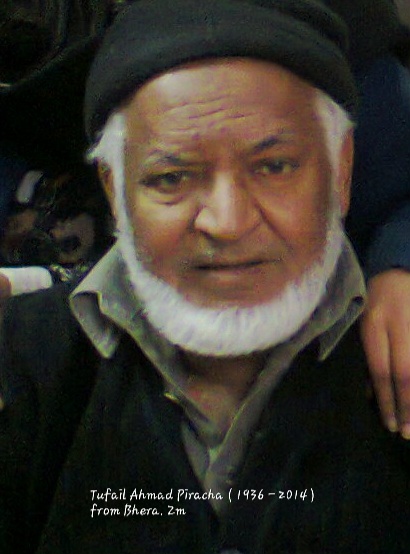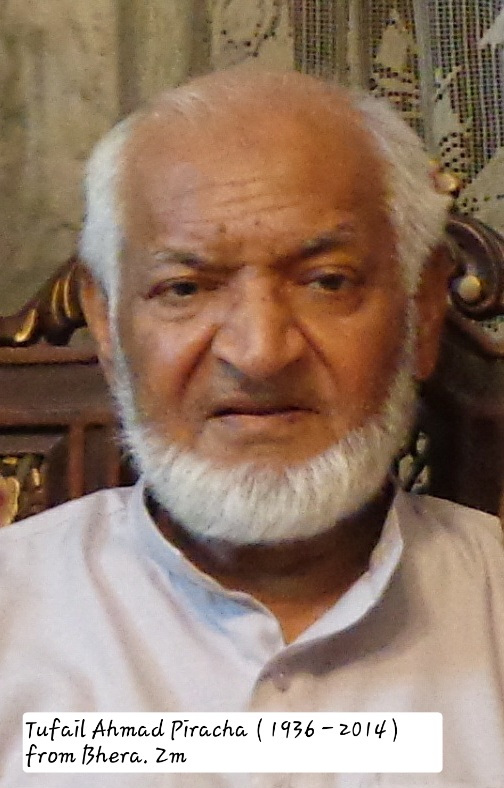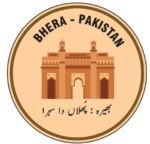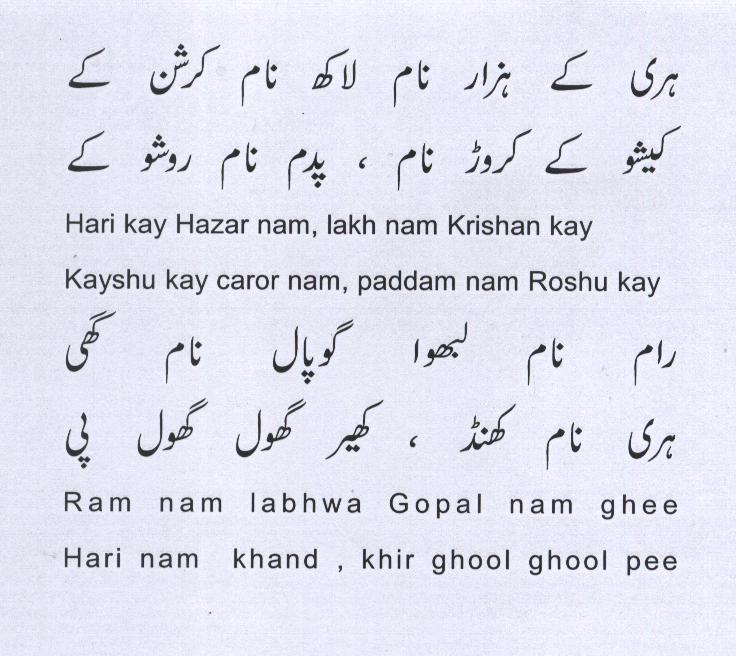I am Tufail Ahmed Piracha from Mohallah Pirachgan, Bhera. I was born in 1936. I started my early education in 1941 at the Primary School Mohallah Pirachgan. The headmaster of the School was Muhammad Siddique and my class teacher was Muhammad Aziz. This school was established by my maternal grandfather Mian Muhammad Ishaq on the ground floor of his house which consisted of four rooms. Although he was a business man but took a keen interest in education. His business extended even up to Kabal and Baghdad.
I studied in Class III and IV in Municipal Committee School No. 2, near Chirri Chog Darwaza. This school is one the oldest schools of Bhera built in 1876 and is still there. That time it was up to class four. Muhammad Nazir was the headmaster of the school and also my class teacher. There was another teacher by the name of Ghulam Muhammad. In the school, there were Hindu and Sikh students also but unfortunately, I do not remember their names.
In 1945, I was admitted to Class V in Government High School, Bhera near the railway station. The new building of the school was constructed in 1927. It was one of the most beautiful schools of its time. On three sides of the school, there were huge grounds where various tournaments were regularly held. Students from far-flung villages also studied in this school. The school had its own boys’ hostel. The first headmaster of the school was Mir Mohsin Shah who was a great administrator and a well-respected man. When I got admission in 1945, Chaudhry Wali Dad from Gujrat was the headmaster. His son Riaz was a class senior to me and his nephew Anwar was my class fellow. God knows where they are now! In 1948 Wali Dad retired and both the boys went back to Gujrat with him. In Class V my teachers were Des Raj, Shiekh Bashir Ahmed, Qureshi Abdul Qayyum and Muhammad Hussain. English as a subject was taught in Class V. The name of the English Book which I studied was Tipping; I still remember a few verses of a poem from this book: I have two hands and so have you . Ram and Abdul have too. One thumb and four fingers stand on each. To touch to point to hold to the knee.
The Nelson Reader was the name of the English book I studied in Class VI; it was the same book which my father, Chaudhry Bashir Ahmed Piracha read. The age difference between me and my father is 30 years. The only difference between my father’s book and the book my classmates purchased was a picture of King George. In my father’s book, the picture was of King George V and in the new book the picture was of King George VI. So I did not purchase a new book. In Class VI my teachers were Nazar Muhammad from village Gaga who taught English, and Molvi Muhammad Abdullah taught the remaining subjects. Both were very strict, made us work hard and taught with a lot of dedication.
In Class VII we had the option to take Arabic or Persian as a subject. In this class, my teachers were, Sheikh Muhammad Mumtaz, a slim fellow from Mohallah Shiekhanwala, who wore pent and coat and solar hat, used to come to school on a bicycle, Hans Raj from Mohallah Chitti Pully was a religious and hefty person. Every morning he used to go to river Dhebaywala with Gadvi in his hand for Ashnan and prayers, he taught Mathematics. Saleem Bhatti was our Persian teacher. The names of the other teachers were Qazi Muhammad Siddique (English), who later became the headmaster, Fazal Ellahi (Drawing), Ch Muhammad Rahim (Mathematics and Science), Nathu Ram and Mulak Raj (English), Farman Ali Shah (Maths), Molvi Saif ur Rehman (Arabic), Khaliq Shah from Ali Pur Syedan (English), Alam Uddin Momin (English and Urdu), Mir Mukhtar (Maths), Ch Sher Ali, Muhammad Yousaf, Master Manzoor, a lame fellow, Molvi Zubair, Ch Barkat Ali, who belonged to a village near Bhalwal was our PT Master. He was also in charge of games and made us do PT every day. At that time Bhera High School produced many outstanding players. Close to our school, there was another renowned high school by the name of Arya High School (now it is Girls Higher Secondary School). In this school, 98 per cent of students and teachers were Hindus and two per cent were Muslims. The Muslim students thought that the education standards of Arya School were better than Government High School Bhera.
On the way back to school, we used to pass by Sita Ram Bagh, now called Islami Bagh. In the open ground, Hindu men used to beat harvested mehndi with big sotas (strong big sticks), segregate the mehdi leaves from branches, dried them before further processing. Hindu women in streets spun thread on hand looms for making Khes and Duries. There was a small Hindu temple on a tibia at the end of a street before it took a westward turn, north of Ghas Mandi, probably its name was Jia Krishna da Mandir. I don’t think it had a big vertical structure like other Hindu Temples. What was written on the gate of the temple we as children learnt it by heart. Not knowing precisely whether we were supposed to learn and sing it. But we did sing on our way back home. I can still recall the wordings:
There were two shops of Hindus in our mohallah, one was of Lal Panju and the other was of Shani son of Kishan Dayal. Lal Panju earned a lot from his small shop; the main reason was that women of our mohalla were comfortable with him and purchased things from him on loan, for he had honestly maintained a register. Men of our mohallah were either businessmen or agriculturists and for business, they had to go as far as Calcutta. So they never bothered about purchasing daily-use items. They left this to their women. As a child, I used to visit Lal Panju’s shop with one paisa and say: Dhelay kay hum lok dey, dhela maira rok dey or dhelay ki moong phalli dey, dhela maira rok dey. Rok dey ment, return half paisa. One paisa had two dhalas and a rupee had 64 paisas. On the one paisa coin, there was a picture of bold headed king,
I can not recall his name. After the Partition Lal Panju settled in New Delhi. He visited Pakistan in 1948/49, went to his house, and carried out digging of one of the floors, probably he had buried some jewellery there but could not find any.
Before partition when a Hindu died in Bhera or surrounding areas his arthi (dead body or Baban) was brought to Chrri Chung mandir for rites before it was taken to Shamshan Ghat for cremation near the banks of river Dhebaywala. At that time the river Dhebaywala was approximately 3 to 4 kilometers away from Bhera. So the Hindus had to walk a long distance for the cremation of their dead. I remember because I followed the funeral procession a couple of times as a child. The route on which arthi was taken was called Kararianwali Sarak, the locals of Bhera called Hindu men Karar and Hindu women Karari. After crossing the road the procession passed through Marriwala Khu (well), near Bauliwala mandir. Then it took a westward turn, about a furlong or so on the left, there was a small mandir, and another furlong ahead of it was a place called Ghari Bhun. After performing rites at this place procession crossed Noon na wala nullah through a small bridge, which was about a furlong or so from Ghari Bhan. Another furlong ahead was Dhabby wala Darya, it was called by this name because washermen used to wash clothes there. Next to it was Shamsham Ghat where chitta was burnt. When the skull of the dead body busted due to intense fire, Hindus used to say:
Siri Pathaka Mara, Bhai Bhajan Karo. Bhai Bhajan Karo. After two to three days remnants of the dead body were collected and thrown in Dhebaywala /Jhelum River. In the early 1950s, the Jhelum River came quite close to Bhera due to erosion and wrapped in it Dhebaywala dariya, Noon na wala nallah and some agricultural lands. With the construction of the Mangla Dam, water was controlled and erosion of the river stopped but the floods of 1992, once again devastated the lands on both banks of river Jhelum and Bhera town itself. The town suffered a colossal amount of damage due to this flood.
I vividly remember three Hindu festivals in Bhera before the Partition i.e. Dhosshara, Dewali and Paddakna,( it was the local word for the festival, but I do not remember the actual name). Dosshara was held in the open ground outside Chitti Pulli Darwaza, towards the north of it is a Muslim graveyard. A very tall frame, approximately 60 to 70 feet high with a base of 10 to 12 feet was prepared. On it face of Rawan was made with paper and other material with seven heads. The story of Ram Leela was narrated and an interesting fight between the forces of Ram Chandhar Jee, Sita Jee and Rawan was portrayed. At some stage, Hanuman forces also joined the fight. On the festival’s last day, seven heads of Rawan were blown off; they were filled with bad (explosives). We as children very inquisitively watched the festival, neither Hindus nor our parents prevented us from seeing it. On the festival of Dewali, Hindus threw colours on each other with other celebrations. I do not know the background of the Paddakhna festival; or why it was celebrated. The main feature of it was that Hindu women in their colourful dresses stood on the circular road with Thals (large trays), containing methi phulian (something like roasted sugar-coated rice), Churi, sweets and few other items. They distributed these to all children. We as young boys enjoyed this festival because there was something to eat.
I appeared in matriculation exams in March 1951. At that time school was under Punjab University. The same year there was a famous cheating case in Bhera High School. The school was the centre for matriculation exams. A high-level court of inquiry was held. Above 100 students who appeared from Bhera High School centre were rusticated whether guilty or not for one to two years. I was also one of the victims, so I appeared in matric exams in 1952.
The design of Chrri Chung Darwaza was changed in the early 1950s. Because Shia’s Tazia could not pass under it, the height of the gate was raised. It was done at the time of Sheikh Muhammad Aslam who was the then Chairman Municipal Committee, Bhera.
Before Partition Bhera’s cottage industry was flourishing and well known. Handmade Durries, Khais, and Lungies were in high demand. Mohallah Loharan de Mori was famous for cutlery items and decorated sticks with stones and mother-of-pearl work. These were presented to rajas and maharajas as souvenirs all over the subcontinent. Due to several reasons, this art has completely vanished from Bhera. Similarly is the case with the cottage industry.
Probably the first ICS from Bhera was my real maternal uncle Mr M Ayub, he passed the ICS exam from London in 1936. He was the first Secretary of Finance of the Government of Pakistan and later became a Director at the World Bank, Washington D.C. My other uncle was Air Cdr MM Piracha, who was Deputy Chief of Air Staff (Administration) Pakistan Air Force at the time of Air Marshal Asghar Khan. Another old timer Wing Cdr N A Sheikh was also from mohallah Pirachgan – Bhera. Chaudhry Sher Ali’s son, Chaudhry Muhammad Anwar, Siddiqui Hassan Qureshi, Mufti Lutaf Ullah and Tariq Qureshi were my class fellows and friends. Chaudhry Muhammad Anwar remained in a good post in the Agriculture Department. Mufti Lutaf Ullah did CSS and retried as Secretary Religious Affairs. Tariq Qureshi went to the USA.
I would say we had good relations with the Hindu families of Bhera before the Partition. On the occasion of marriages, gifts were exchanged. At that time Bhera was a flourishing town, its economy was good, people were generally happy and it had much more colourful and cleaner looks. Local politicians took a keen interest in the welfare of people and Municipal Committee Bhera was quite effective. To be continued …
Note: Tufail Ahmed Piracha died on 11 September 2014 in Rawalpindi. He was buried in Pir Mulamay Qaristan, Bhera. May Allah Almighty bless his soul! Ameen. Unfortunately, I couldn’t record Part 2 of his memoirs of Bhera. See his video recording of his remembrances on the Website bhera.org ( in the category of documentaries of Bhera).
Zahid Mumtaz



